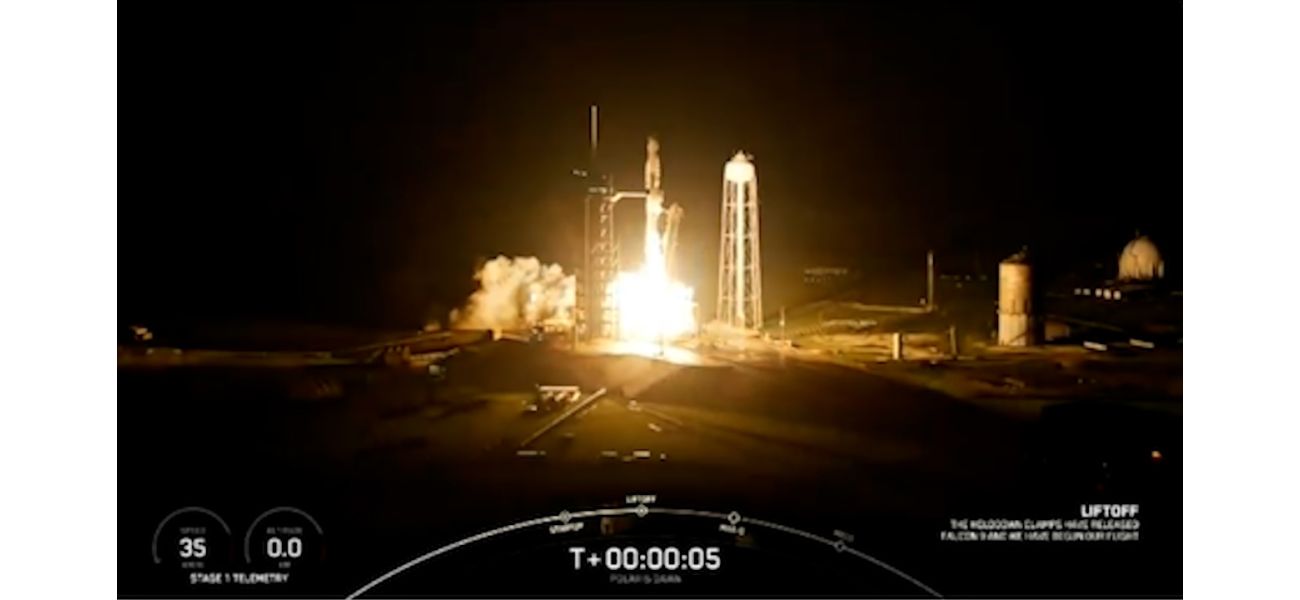SpaceX sends crew on risky journey through Earth's radiation belts.
A billionaire has launched into space for a historic private spacewalk, breaking records on their mission.
September 10th 2024.

SpaceX's most recent mission has taken flight, embarking on a daring and risky journey into Earth's Van Allen radiation belts. The four-person crew, made up of civilians, will not only be the first to conduct a commercial spacewalk but also the first SpaceX employees to venture into space. The mission, named Polaris Dawn, launched at 5:23 am ET and was livestreamed on X, the social media platform formerly known as Twitter which was purchased by CEO Elon Musk in 2022.
As the capsule entered Earth's orbit, ground controllers, led by SpaceX launch director Frank Messina, offered words of encouragement to the crew. "As you gaze towards the North Star, remember that your bravery will pave the way for future explorers. We have full faith in your skills, courage, and teamwork to successfully complete the mission ahead," they said. They also assured the crew that the entire team back on Earth was with them every step of the way, sending them hugs and support.
This launch came after several weather delays in late August and earlier that morning, which hindered the Polaris Dawn crew's efforts to take off. Adding to the challenges, SpaceX not only needed clear weather for the launch, but also calm waters and winds for the crew's return after their five-day excursion. Timing their return is crucial as the spacewalk will deplete the oxygen supply, giving the crew only enough life support for five or six days in space.
Initially, a problem with ground equipment at the launch site delayed the launch by 24 hours, and then weather forecasts caused two more attempts to be cancelled. Around the same time, a Falcon 9 rocket, the type that will power Polaris Dawn's journey, malfunctioned during a routine satellite mission. This prompted federal regulators to briefly halt all Falcon 9 rockets from flying. However, on August 30, SpaceX received permission to resume flights with the Falcon 9.
Now, the company is attempting one of its riskiest missions to date, although the weather could still pose a challenge. According to a post on X by SpaceX, the latest forecast puts the odds of unfavorable conditions for a Tuesday launch at 60%. The company not only needs clear weather for the launch, but also for the calm waters and winds required for the crew's return from their five-day excursion.
The ride to orbit was an exhilarating experience. After the countdown clock hit zero, SpaceX's Falcon 9 rocket roared to life, creating a blinding blaze and deafening blast across the launch site at NASA's Kennedy Space Center in Florida. The crew was strapped inside an igloo-shaped SpaceX Crew Dragon capsule, measuring about four meters across at its base, as the rocket launched them away from Earth's gravity.
After firing for 2 ½ minutes, the first stage of the Falcon 9 rocket, which had been using most of its fuel, detached from the second stage. The upper portion of the rocket continued to propel the Crew Dragon spacecraft at higher speeds. Meanwhile, the first stage guided itself back to Earth and landed on a seafaring platform. This signature SpaceX move helps reduce the cost of rocket launches, as the first stage can be refurbished and used on future missions.
To enter Earth's orbit, the Falcon 9 rocket needed to reach a speed of over 27,358 km/h, also known as "orbital velocity." Once it reached this speed, the Crew Dragon separated from the rocket and navigated the vacuum of space using its onboard thrusters for the rest of the mission.
This mission, Polaris Dawn, is the brainchild of SpaceX and billionaire Jared Isaacman, the founder of financial technology firm Shift4 Payments. In September 2021, Isaacman made his first foray into spaceflight with the Inspiration4 mission. However, this flight is not just for fun. Isaacman and his crewmates, including his close friend and former US Air Force pilot Scott "Kidd" Poteet, as well as SpaceX engineers Anna Menon and Sarah Gillis, hope to achieve several milestones on this mission.
One of their goals is to reach record-setting heights for an orbit around Earth, surpassing the record set by NASA's 1966 Gemini 11 mission, which reached 1,373 kilometers. If successful, Polaris Dawn would beat this record by about 32 kilometers. It would also be the highest any human has flown since NASA's Apollo program, which ended in 1972 and carried 24 astronauts about 400,000 kilometers to the moon instead of stopping in Earth's orbit.
Polaris Dawn may also mark the farthest any woman has ever gone into space. On day three of the mission, while orbiting at a lower altitude of about 700 kilometers above Earth, the crew will attempt a history-making spacewalk. This endeavor is extremely dangerous and will expose all four crew members and the interior of the Crew Dragon to the vacuum of space. This could make it challenging to relock the hatch due to the pressure difference, and exposure to the vacuum could release toxins when the cabin is repressurized. However, SpaceX has taken steps to prevent this.
In conclusion, the Polaris Dawn mission is a significant and exciting milestone for SpaceX, as they embark on their riskiest mission to date and strive to achieve multiple records and firsts. The entire team back on Earth is cheering them on, and we can't wait to see what they accomplish on this journey into space.
As the capsule entered Earth's orbit, ground controllers, led by SpaceX launch director Frank Messina, offered words of encouragement to the crew. "As you gaze towards the North Star, remember that your bravery will pave the way for future explorers. We have full faith in your skills, courage, and teamwork to successfully complete the mission ahead," they said. They also assured the crew that the entire team back on Earth was with them every step of the way, sending them hugs and support.
This launch came after several weather delays in late August and earlier that morning, which hindered the Polaris Dawn crew's efforts to take off. Adding to the challenges, SpaceX not only needed clear weather for the launch, but also calm waters and winds for the crew's return after their five-day excursion. Timing their return is crucial as the spacewalk will deplete the oxygen supply, giving the crew only enough life support for five or six days in space.
Initially, a problem with ground equipment at the launch site delayed the launch by 24 hours, and then weather forecasts caused two more attempts to be cancelled. Around the same time, a Falcon 9 rocket, the type that will power Polaris Dawn's journey, malfunctioned during a routine satellite mission. This prompted federal regulators to briefly halt all Falcon 9 rockets from flying. However, on August 30, SpaceX received permission to resume flights with the Falcon 9.
Now, the company is attempting one of its riskiest missions to date, although the weather could still pose a challenge. According to a post on X by SpaceX, the latest forecast puts the odds of unfavorable conditions for a Tuesday launch at 60%. The company not only needs clear weather for the launch, but also for the calm waters and winds required for the crew's return from their five-day excursion.
The ride to orbit was an exhilarating experience. After the countdown clock hit zero, SpaceX's Falcon 9 rocket roared to life, creating a blinding blaze and deafening blast across the launch site at NASA's Kennedy Space Center in Florida. The crew was strapped inside an igloo-shaped SpaceX Crew Dragon capsule, measuring about four meters across at its base, as the rocket launched them away from Earth's gravity.
After firing for 2 ½ minutes, the first stage of the Falcon 9 rocket, which had been using most of its fuel, detached from the second stage. The upper portion of the rocket continued to propel the Crew Dragon spacecraft at higher speeds. Meanwhile, the first stage guided itself back to Earth and landed on a seafaring platform. This signature SpaceX move helps reduce the cost of rocket launches, as the first stage can be refurbished and used on future missions.
To enter Earth's orbit, the Falcon 9 rocket needed to reach a speed of over 27,358 km/h, also known as "orbital velocity." Once it reached this speed, the Crew Dragon separated from the rocket and navigated the vacuum of space using its onboard thrusters for the rest of the mission.
This mission, Polaris Dawn, is the brainchild of SpaceX and billionaire Jared Isaacman, the founder of financial technology firm Shift4 Payments. In September 2021, Isaacman made his first foray into spaceflight with the Inspiration4 mission. However, this flight is not just for fun. Isaacman and his crewmates, including his close friend and former US Air Force pilot Scott "Kidd" Poteet, as well as SpaceX engineers Anna Menon and Sarah Gillis, hope to achieve several milestones on this mission.
One of their goals is to reach record-setting heights for an orbit around Earth, surpassing the record set by NASA's 1966 Gemini 11 mission, which reached 1,373 kilometers. If successful, Polaris Dawn would beat this record by about 32 kilometers. It would also be the highest any human has flown since NASA's Apollo program, which ended in 1972 and carried 24 astronauts about 400,000 kilometers to the moon instead of stopping in Earth's orbit.
Polaris Dawn may also mark the farthest any woman has ever gone into space. On day three of the mission, while orbiting at a lower altitude of about 700 kilometers above Earth, the crew will attempt a history-making spacewalk. This endeavor is extremely dangerous and will expose all four crew members and the interior of the Crew Dragon to the vacuum of space. This could make it challenging to relock the hatch due to the pressure difference, and exposure to the vacuum could release toxins when the cabin is repressurized. However, SpaceX has taken steps to prevent this.
In conclusion, the Polaris Dawn mission is a significant and exciting milestone for SpaceX, as they embark on their riskiest mission to date and strive to achieve multiple records and firsts. The entire team back on Earth is cheering them on, and we can't wait to see what they accomplish on this journey into space.
[This article has been trending online recently and has been generated with AI. Your feed is customized.]
[Generative AI is experimental.]
0
0
Submit Comment





